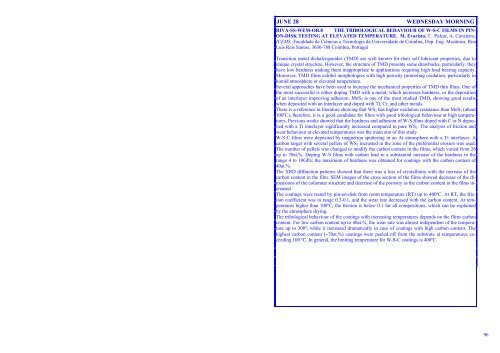Wüest M. 51 Wykes M. 82 Yamaguchi M. 17 Ybarra G. 129 Yubero F ...
Wüest M. 51 Wykes M. 82 Yamaguchi M. 17 Ybarra G. 129 Yubero F ...
Wüest M. 51 Wykes M. 82 Yamaguchi M. 17 Ybarra G. 129 Yubero F ...
You also want an ePaper? Increase the reach of your titles
YUMPU automatically turns print PDFs into web optimized ePapers that Google loves.
JUNE 28 WEDNESDAY MORNING<br />
RIVA-SS-WEM-OR.8 THE TRIBOLOGICAL BEHAVIOUR OF W-S-C FILMS IN PIN-<br />
ON-DISK TESTING AT ELEVATED TEMPERATURE. M. Evaristo, T. Polcar, A. Cavaleiro,<br />
ICEMS -Faculdade de Ciências e Tecnologia da Universidade de Coimbra, Dep. Eng. Mecânica, Rua<br />
Luís Reis Santos, 3030-788 Coimbra, Portugal<br />
Transition metal dichalcogenides (TMD) are well known for their self lubricant properties, due to<br />
unique crystal structure. However, the structure of TMD presents some drawbacks, particularly, they<br />
have low hardness making them inappropriate to applications requiring high load bearing capacity.<br />
Moreover, TMD films exhibit morphologies with high porosity promoting oxidation, particularly in<br />
humid atmosphere or elevated temperature.<br />
Several approaches have been used to increase the mechanical properties of TMD thin films. One of<br />
the most successful is either doping TMD with a metal, which increases hardness, or the deposition<br />
of an interlayer improving adhesion. MoS 2 is one of the most studied TMD, showing good results<br />
when deposited with an interlayer and doped with Ti, Cr, and other metals.<br />
There is a reference in literature showing that WS 2 has higher oxidation resistance than MoS 2 (about<br />
100ºC), therefore, it is a good candidate for films with good tribological behaviour at high temperatures.<br />
Previous works showed that the hardness and adhesion of W-S films doped with C or N deposited<br />
with a Ti interlayer significantly increased compared to pure WS 2 . The analysis of friction and<br />
wear behaviour at elevated temperatures was the main aim of this study.<br />
W-S-C films were deposited by magnetron sputtering in an Ar atmosphere with a Ti interlayer. A<br />
carbon target with several pellets of WS 2 incrusted in the zone of the preferential erosion was used.<br />
The number of pellets was changed to modify the carbon content in the films, which varied from 26<br />
up to 70at.%. Doping W-S films with carbon lead to a substantial increase of the hardness in the<br />
range 4 to 10GPa; the maximum of hardness was obtained for coatings with the carbon content of<br />
40at.%.<br />
The XRD diffraction patterns showed that there was a loss of crystallinity with the increase of the<br />
carbon content in the film. SEM images of the cross section of the films showed decrease of the dimensions<br />
of the columnar structure and decrease of the porosity as the carbon content in the films increased.<br />
The coatings were tested by pin-on-disk from room temperature (RT) up to 400ºC. At RT, the friction<br />
coefficient was in range 0.3-0.1, and the wear rate decreased with the carbon content. At temperatures<br />
higher than 100ºC, the friction is below 0.1 for all compositions, which can be explained<br />
by the atmosphere drying.<br />
The tribological behaviour of the coatings with increasing temperatures depends on the films carbon<br />
content. For low carbon content up to 40at.%, the wear rate was almost independent of the temperature<br />
up to 300º, while it increased dramatically in case of coatings with high carbon content. The<br />
highest carbon content (∼70at.%) coatings were peeled off from the substrate at temperatures exceeding<br />
100 ºC. In general, the limiting temperature for W-S-C coatings is 400ºC.<br />
96
















